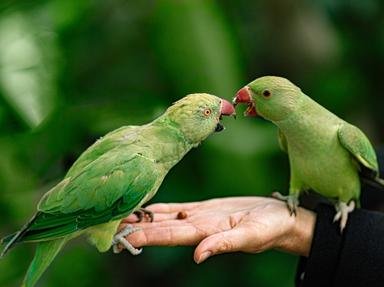Quiz Answer Key and Fun Facts
1. A member of the intelligent Corvidae family, what bird able to imitate human sounds also has been known to collect shiny objects and engage in play?
2. The grey parrot is known for its ability to learn human sounds and to interact playfully with its human owners, can learn to speak hundreds of words, and may be able to identify colors, shapes, quantities, and other attributes. On what continent can grey parrots be found in the wild?
3. What Asian member of the starling family, with a scientific name that makes it sound religious, is known for its ability to imitate sounds in its environment, including human speech and whistled tunes?
4. Perhaps the most loving of birds and known for their elaborate singing repertoire, cockatiels enjoy looking at themselves in mirrors and other reflective surfaces. With what feature of their anatomy do pet cockatiels exhibit their moods or feelings?
5. A few of the 27 species of Amazon parrot can learn to imitate human words, and they are popular pet birds. In the wild, in South and Central America, they forage for a variety of tree nuts, fruits, vegetables, and insect grubs. What foods should you never give to your pet Amazon parrot?
6. The national bird of Honduras, often captured for the exotic pet industry, what colorfully named, large member of the parrot family in South and Central America is actually made up of a number of colors including red, green, yellow, white and several shades of blue?
7. Able to acquire an extensive vocabulary, what small, highly social pet bird with alternate names that sound religious, has become feral in some parts of North America and Europe?
8. What common name is given in its native Australia to the colorful small bird, often kept as a pet, whose binomial name is Melopsittacus undulates, which translates to "wave-patterned melodious parrot" in English?
9. The white, crested bird in a 1650 painting by Flemish artist Adriaen van Utrecht perches on the back of a chair that holds a delicious heap of fruit. Its living model probably was captured by a Dutch trader/explorer on one of the islands of what is now Indonesia. What is the name of this species, often kept as an intelligent, though difficult, pet bird that can sometimes learn a few words of human speech?
10. Referring to canaries, what do the terms Spanish timbrado, German roller or Hartz Mountain roller, and Belgian waterslager or Malinois signify?
Source: Author
nannywoo
This quiz was reviewed by FunTrivia editor
Tizzabelle before going online.
Any errors found in FunTrivia content are routinely corrected through our feedback system.

